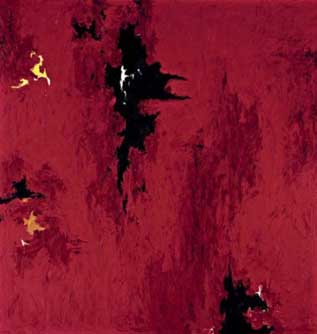
|
||
|
Portland art blog + news + exhibition reviews + galleries + contemporary northwest art
|
||
A Distinguished Guest: Clyfford Still at PAM  On my most recent stroll through the Portland Art Museum I came across another distinguished painting on loan, Clyfford Still's 1947-R-no.1, which set the auction record for a Still late last year at a mere $21,296,000. Aside from gawking at the price (Im over it), which most certainly would have brought the ire of an artist famous for focusing on philosophical integrity rather than the art market, it's a great chance to see one of the few unrestricted Still's in private hands. He's one of my favorite artists and I absolutely respect his far-sighted convictions and principles. During his lifetime Still only sold 150 unrestricted paintings, which is why this work is so valuable. Still chose to keep the rest of his output in his estate, which will eventually be housed in the Clyfford Still Museum in Denver (Portland's Brad Cloepfil is the architect for the project). Now the important part, the painting. The 6 foot square oil is one of the most heavily worked Still's I've ever seen. By 1947 the artist had solidified his signature style and one senses he had worked out a lot of ideas in this piece. It's a painter's painting; no wonder collector/painter Alfonso Ossorio originally acquired it. Still famously scrutinized his collectors, one time even denying a young Walter Hopps one of his works because he didn't feel he was ready for the "responsibility." It was painted in San Francisco* as Still was teaching at the California School of Fine Arts in 1946-47. He returned to New York in 1948. Sadly, the jpeg picture here (from Christies' auction promotions) conveys none of the texture, in addition to having inaccurate color. The dark red areas around the black in the jpeg are actually more of a brown with a very matte gloss. As with many major Stills the texture is very important. Here the fields of deep red go from the juiciness of slightly rotten tomatoes trampled under foot to a more matte finished paprika. Most of the black has a flat, almost charcoal or basalt finish; The Art Institute of Chicago's "monster" is a later tour de force in this black. The brown areas seem to have been scraped onto higher outcroppings of the paintings topography so up-close it seems to float on top of the red surface. From a distance the black areas come forward but are often less built up than the brown areas surrounding them. In later years his work was generally less built up and seem less of a painter's struggle to pull it off. With Still struggle is an important part of the work but I like how this is still a technical issue in this early but fully realized, mature work. Another treat is this work's current proximity to a rare early Still from 1940 on view (untitled and lent by local collectors Will Emery and Bonnie Serkin). Together it provides a great opportunity to compare Still's progress over those 7 intervening years. The 1940 work came before the breakthrough style but it's still successful if much less ambitious. The pallet knife work is less fevered and the jagged forms more resemble nurse logs from a Pacific Northwest forest. Still went to college in Spokane, and later taught at Washington State College in Pullman from 1933-1941 so sights like that would have surrounded him. There is even a portrait of a fellow professor on the other side. By comparison, in 1947 his work looked little like anything else and the tree like forms were completely replaced with elements that are more like jagged scars. 1947-R-no.1 is also a lot earthier and less atmospheric. Still is a geologist's kind of painter and 1947-R-no.1 is one of the best examples of nearly geological accretion I have seen from him so far. There has been precious little study of Still and the new museum in Denver will finally allow a great deal more consideration of his work. 1947-R-no.1 is a sumptous painting go see this while you can. [*confirmed by Dean Sobel Director of the Clifford Still Museum by way of Tyler Green, thanks for the research] Posted by Jeff Jahn on January 24, 2007 at 11:49 | Comments (3) Comments That makes this the 2nd Abstract Expressionist auction record setter ...what's next? High kudos for the anonymous lendor(s)! Posted by: bradc I haven't had the chance to see either the Rauschenberg or the Still. Especially the Still piece. I am very anxious to see it. Posted by: Calvin Ross Carl Thanks for bringing attention to this piece and its underestimated maker. Who is the current owner? Posted by: cicolini Post a comment Thanks for signing in, . Now you can comment. (sign out)
(If you haven't left a comment here before, you may need to be approved by
the site owner before your comment will appear. Until then, it won't appear
on the entry. Thanks for waiting.)
|
| s p o n s o r s |
 |
 |
 |
 |
 |
 |
 |
 |
 |
 |
 |
 |
 |
 |

|
Site Design: Jennifer Armbrust | • | Site Development: Philippe Blanc & Katherine Bovee | |


![[TypeKey Profile Page]](http://www.portlandart.net/nav-commenters.gif)